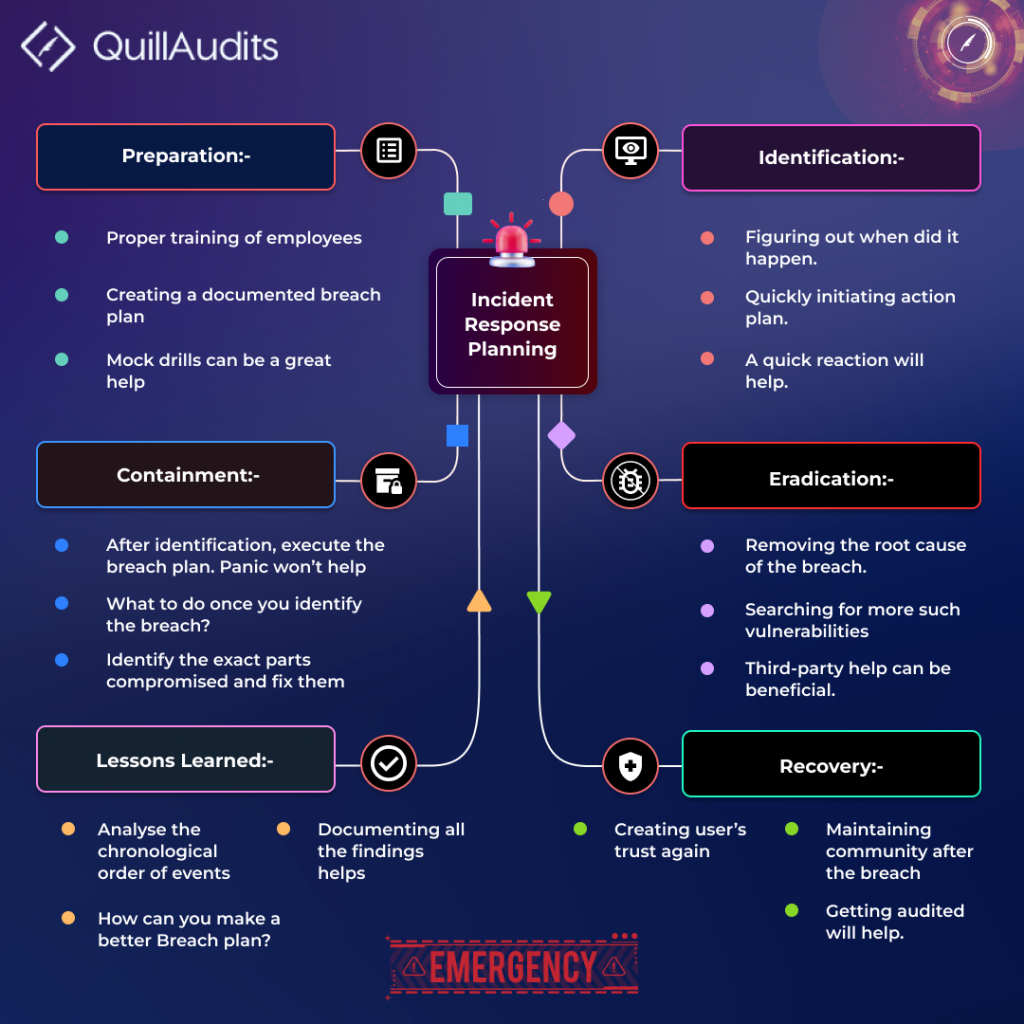Read Time: 5 minutes
No matter how hard you try to secure your house from a security breach, you never know what the thief is packing. No matter how secure your locking system is, you never know the skillset of the stealer. In simple words, no lock in the world can’t be picked. What if I tell you there is no way you can be 100% sure your protocol won’t be compromised?
This world is a game of possibilities and probabilities. No matter how secure you think you might be, there is always that one possibility you might or might not know about, which can be very devastating. This does not mean that you give up on security. The game is about increasing your odds of saving yourself from the attacks.
In this blog, we will discuss the incident response plan which should be set up and followed in case of a security breach to mitigate any further losses and save yourself, Let’s go.
Preparation
This step is taken before the security breach. You know those military drills the soldiers go through in the field to be ready in case the situation arises? This is that part. Here we are preparing ourselves in case we face any security breach. You see how bad it would be if one day you woke up and found a security breach, you would just panic, and it would get too late to form a plan, so we make a plan beforehand.
This preparation includes proper training of the employees based on their roles in case of a security breach. Let them know beforehand who does what in case there is a security breach,. We also need to conduct regular mock drills assuming there has been a security breach so that everyone is well trained and ready, and the most crucial aspect, prepare a well-documented response plan and keep updating it in case of changes.

Identification
One of the most important phases is the place where you need to be as quickly as you can be. Imagine a needle coming over your skin, and the longer you ignore the deep it will go into you, the quicker you react less the impact it will have.
Identification is when you figure out that something has gone wrong is going wrong. At this stage, you determine whether you have been breached, and it can originate from any area of your protocol. This is the stage where you ask questions like when did it happen? What areas are impacted, the scope of compromise etc.
Containment
This part can be tricky, this is where you have to be very clever and very cautious, and it can get complex quickly. There was a nuclear incident at Chornobyl. There is a whole series based on it. The toughest part of that incident was containment. How would you contain the impact so that we can mitigate the risk? (If you haven’t seen the series, Iwe highly recommend it 🙂 ).
When we discover the breach, the first natural response is to shut everything down, but that, in some cases, may inflict more damage than the breach itself, so rather than going wild and stopping everything in the protocol, it is advisable to contain the breach so that it does not cause any further damage. The best strategy is to identify quickly the parts most likely affected and work on them as quickly as possible however, sometimes that is not possible, so we may need to really stop the whole operation.
Eradication
After the containment step, we are left wondering how it started in the first place, what’s the root cause of it, and how did it even happen? These are the question which will haunt us the next time again if we don’t answer them, and to know this, we will have to do good research about the attack, where it originated from, and what were the chronologies of the events. etc.
This part is sometimes easier said than done. It can be hectic, complex and troublesome to get to the root of the hacks, and that’s where companies like QuillAudits can help you. If needed, you can take third-party companies’ help to figure out how it all happened and what needs to be done ahead.
Recovery
This is a part where you feel that you should have invested and focused more on the security aspect of your firm beforehand with the help of companies like QuillAudits because, in recovery, you will have to again go through building trust with the users.
In recovery, you will have to again go through with a new start. Making people believe you are safe. It is not an easy task once you have been hacked in the Web3 world. However, audit reports are known to be the key to such problems. An audit report from a well-known organisation can build trust with your user space.
Lessons Learned
One of the most crucial parts, all these steps will be useless if you don’t learn from them. You being hacked once means the need for a more robust and secure system and protocol. This step includes analyzing and documenting the event and every detail of how it happened and what we are doing to prevent getting breached again, this step involves the whole team, and with coordination only, we can see some progress in a more secure-based journey.
Conclusion
Security threats have been increasing in numbers for the last few years continuously. It calls for the special attention of developers and buidlers in Web3. You can not be ignorant of your security issues because that one vulnerability can be a matter of success or failure for your protocol. Join QuillAUdits in making Web3 a safer place. Get your project audited today!
26 Views
- SEO Powered Content & PR Distribution. Get Amplified Today.
- Platoblockchain. Web3 Metaverse Intelligence. Knowledge Amplified. Access Here.
- Minting the Future w Adryenn Ashley. Access Here.
- Source: https://blog.quillhash.com/2023/04/18/how-to-prepare-for-a-web3-security-breach-incident-response-planning/



